Step Drift : MAZDA RX8 Reviews
Vehicle Make and Model: Mazda RX8
Years in Production: 2004, 2005, 2006
Models - Coupe
The Mazda RX-8 is a car manufactured by Mazda Motor Corporation which first appeared in North America at the North American International Auto Show in 2001. The vehicle features a 250 PS JIS (184 kW, 247 hp) @8500rpm (238 SAE net hp for North America) RENESIS Wankel rotary engine, which won International Engine of the Year and Best New Engine awards in 2003 and holds the "2.5 to 3 liter" size award for 2003 and 2004. The engine redlines at 9000 rpm, and cuts off fuel at 9500 rpm. As of March 31, 2005, 114,444 RX-8 models had been sold worldwide since introduction.
The RX-8 was also Wheels magazine's Car of the Year for 2003 and was on Car and Driver magazine's Ten Best list for 2004 and 2005. It was nominated for the North American Car of the Year award for 2004 as well. In 2006 it won What Car? Magazine's 'Car of the Year - Best Coupe' award for the 3rd year running in the UK.
One major change in design between the RX-8 and the RX-7 is the addition of a pair of rear-hinged ('suicide') half-doors (similar to the 3rd door in the Saturn coupe), which allow easier access to the two back seats. The RX-8 has no center pillars separating the front and rear doors. The front doors are hinged at the front, and aluminum back doors are hinged at the rear. Because of the overlapped design, the rear doors can only be opened when the front doors are open.
Weight distribution in the RX-8 is a balanced 50/50 in the front and rear. Mazda achieved this by pushing the engine back past the front axle, achieving a Front-midships engine layout.
Mazda’s new Renesis rotary engine is smaller and lighter than prior rotaries, primarily due to the lack of a turbocharger and associated parts. New to its design are a side-intake and side-exhaust. The engine produces 210 PS (155 kW) in the automatic transmission form, and 250 PS (184 kW) in the manual transmission form. Mazda does, however, plan on eventually releasing a Mazdaspeed variant of the RX-8 with a different front facia, upgraded handling, and perhaps a supercharger.
Mazda aggressively trimmed mass from the RX-8 concept by using aluminium and plastic for body panels and installing a carbon composite driveshaft. The dimensions of the RX-8 are virtually identical to those of the Porsche 911 Carrera.
According to Mazda, the RX-8's RENESIS engine was originally developed to potentially use either gasoline or hydrogen as fuel. In February 2006, Mazda revealed that it would start leasing a dual-fuel RX-8 to commercial customers in Japan.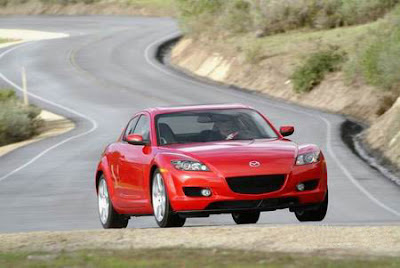
BODY KITS AVAILIBLE FOR MAZDA RX8: To purchase any of the Mazda RX8 Body Kits visit our online shopping cart by Clicking Here
Mazda RX8 Razor Body Kit, also called the RM Body Kit
Mazda RX8 Mint Body Kit
Mazda RX8 Veilside Version 1 Body Kit
Mazda RX8 Veilside DG1 Body Kit
Mazda RX8 Infini Flared Body Kit
Mazda RX8 Buddy Club Body Kit
OUR FAVORITE BODY KITS FOR THE MAZDA RX8:
Our overall favorite body kit for the Mazda RX8 is the Infini Flared body kit by Vision Auto Dynamics. This kit is made from a polyurethane material that is both durable and easy to install. The front and rear bumpers are designed to replace the factory originals, but give the RX8 a much deeper and more aggressive look without being to overbearing. The Mazda RX8 Infini flared body kit is a hot seller and usually is in stock so it can ship out in 3-4 days. Bodykitz gives this kit a thumbs up!
For those looking to spend a little less than the $1200 for the Infini Flared kit, we would have to recommend the RX8 Mint body kit from AIT Racing. This kit is value priced at $799 and features AITs trademark FRP (Fiberglass Reinforced Plastic) material. Lightweight and striking looks are the biggest features, next to its modest price tag. AIT kits are almost always instock, preboxed and ready to ship. This kit usually ships out in 24-48 hours, making this an unbeatable product!
Customer Favorites:
Here are some other body kits and ground effects kits that are hot sellers among our customers as well as some that are a hot trend in the import business:
Invader - The Invader is basically a design based on the worlds most elite ground effects manufacturer "veilside". This common platform has become a big hit in the import tuning community, not just for the body kits but for the Invader stly carbon fiber hoods as well.
Tips:
Before you purchase your body kit or during shipping time, it is a good idea to make sure that you have a qualified installer for your body kit. If you are purchasing a fiberglass kit, it is especially important to find one that can specifically deal with the alterations that may be required to fit your kit correctly. Fiberglass kits in general need some finishing work during installation, such as sanding, primering, filling pinholes/gaps, trimming or shaving. Many times, our customers are charged more than they should if they use a shop who is not familiar with altering fiberglass because of the additional time involved.
Also be sure that whoever is recieving the kit inspects the contents of the box before they sign for it. Although most shipments are recieved undamaged, it is possible that your shipment may be. Because we are not in control of the freight company and thier policies, you must inspect the kit before you sign for it and if it is damaged either refuse the kit and note it on the delivery invoice so that we can file a claim for you.
By http://www.edmunds.com
Tuesday, June 26, 2007
MAZDA RX8 Reviews
Monday, June 25, 2007
The Legendary AE86
Step Drift : Famous Sports Cars - The Legendary Toyota AE86
Perhaps the most popular 1980s sports car to come out of Japan was the Toyota AE86. Often known as the Hachi-Roku, which means eight-six in Japanese, the sports car became incredibly well liked especially after its appearances in the Japanese manga and anime series called Initial D. The Toyota AE86, which was first introduced in 1983, is also famous for being the last small, rear wheel drive coupe.
The car came in two different body styles, the Levin and the Trueno. They were essentially the same thing, with the only difference coming in the shape of its headlights. More variations between the two models later came in 1986, when Toyota changed the tail lights and hatchback styles as well. The cars produced before this change were commonly called "Zenki", which is Japanese for "early period". Toyota AE86 cars made with the new changes were called "Kouki", which unsurprisingly means "latter period" in Japanese.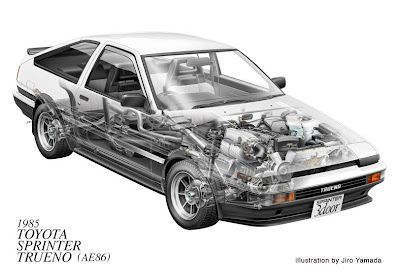
The sports car was also very popular at car shows and was used in various racing sports,
particularly circuit racing and rally driving. Even now, after it has been discontinued, the car remains popular in rally circles and club races. The car was particularly adept at cornering, especially when it was going downhill. As a result, this made it a very common car for mountain pass street races in Japan, known as hashiriyas. The sports car was light, quite powerful, easily modifiable and balanced very well. Keiichi Tsuchiya, the legendary racer in Japan known as Dori-Kin, or "drift king", had also used the car. In fact, with the Toyota AE86, Keiichi Tsuchiya popularized the sport of drifting. To this day it is still popular in drifting competitions because of its fantastic cornering and early association with the sport.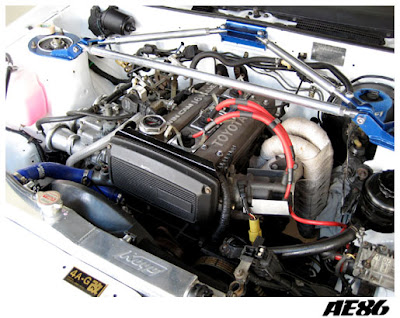
The Japanese manga and anime series, Initial D, also sparked a new interest in the car among automobile and drifting fans all over the world. The car remains so well received that it has been featured in the high-selling, realistic videogame racing series Gran Turismo. Because of its recent attention, the resale value of the car has increased.
The car was originally released in North America under the Corolla name, which stood for "crown of a flower" and came out in 3 different versions. It was also fairly popular in North America, as one version known as the GT-S stayed in production until 1991. The AE86 sports car was also released in Australia under the name Sprinter, but unfortunately, it did not sell so well because the stock engine was poor. However, many Australian car enthusiasts switched the engine and it has been stayed popular for rally and track racing due to its good handling.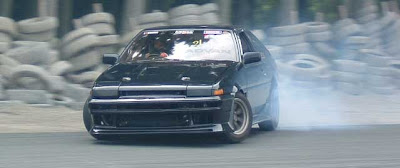
Even though it has been over twenty years since its release, the legendary car is still highly regarded among car enthusiasts due to its wonderful handling and drifting abilities. It continues to gain fame years later since it has been featured in many different car shows, cartoons, games and television series. Since it was also the last of its kind and was used by the legendary drift king, Keiichi Tsuchiya, it looks like the Toyota AE86 is here to stay and drift for years to come.
By http://www.ezinearticles.com/
Friday, June 22, 2007
Subaru Impreza WRX
The range of Subaru Imprezas has been vast, usually involving two or three random letters thrown on after Impreza such as 22B, P1, STi, WRX, WR1 and the list goes on. So here we have another variant of Subaru's classic rally car for the road - the WRX Type-UK.Yes the Impreza WRX Type-UK is an edition just for us Brits. Mechanically identical to the WRX but offering greater value with a security tracking system, touch screen satellite navigation and a Bluetooth hands-free phone kit.

That's not all though, available with free servicing for the first five years or 50,000 miles and an extended warranty taking that cover up to five years or 50,000 miles too.Available for the same price as the standard WRX, the Type-UK starts from £20,945 with the higher-spec SL version costing £22,445. The new 2.5 litre engine used throughout the WRX range provides more torque lower down in the rev-range making the performance more accessible in everyday driving.
Power is up to 230PS and you can feel the improvement behind the wheel, sixty appearing from rest in 5.9s on the way to a maximum of 143mph with a trade off in fuel consumption - from 30mpg to 27.4mpg. Standard equipment levels are high, including air-conditioning, CD player, driver, passenger and side airbags as well as new HID headlamps with pop-up washers. Plus power steering, air-conditioning, remote central-locking, a hill holder clutch, spoiler kit and 15" alloy wheels, so the WRX certainly doesnt want for standard equipment.
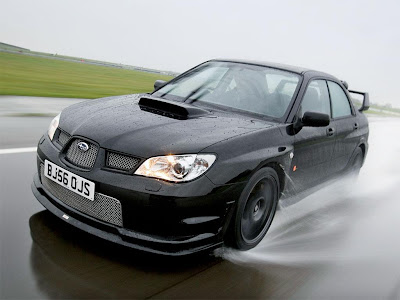
Factor in a Category One remote alarm and immobiliser, sports seats and four-channel anti-lock brakes, and it looks good value. The engineers at Subaru have spent most effort fine-tuning the engine, suspension, bodyshell and steering making the latest generation Impreza a more complete package if not quite so exciting as the original first generation model.The Type-UK deal is for a limited period.Hill Holder - A small rear brake that, after being set by the brake pedal, whilst the clutch is depressed the car will not roll back.
By japmobiles
Nissan Sil80
Step Drift : Nissan Sil80
The SilEighty (pronounced shilla eytee) is a King of drift machines. It started with car accidents, illegal racing and Nissan actually seeing what people were doing. The Nissan Silvia was not realeased over here but is based on the 200sx chassis. The Nissan 180SX is Japans version of the S13 200sx with an SR20DET engine. In Japan, Silvias have three levels of trim (K[ing]'s, Q[ueen]'s, J[ack]'s) K's being the 2.0 Turbo charged SR20DET engines which could making well over 200bhp, Q's being the non-turbo 2.0 liter engines putting out just around 150-170bhp.When Nissan had several FR turbo powered cars such as the Silvia and the 180SX, 180SX drivers bought them for drifting.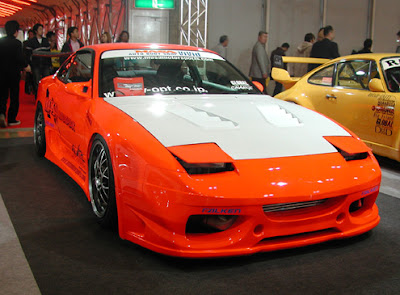
However when learning to drift through the touge (Pronounced "Toe-Gay"), accidents do happen resulting in damaged front ends. The front end parts of Silvias were less expensive than the 180SX with pop up lights, and sharing the same platform the parts bolted on without many complicated steps. Nissan realised this trend, and built a 180sx with a Silvia front end. Literally a SILvia 180.
Nissan kept production of the Sileighty low key owing to it's street racing roots and took the press by suprise when it was launched in mid 1994. It is said that just 400 Sileighty's were built.To separate the Sileighty from the botch jobs made at home Nissan added 24bhp through hotter cams and ecu tweeks. The suspension was modified, resulting in a very hard rear setup to snap oversteer to enable drifting through series of tight turns. The rarity value of a Drift car from the factory, and the Initial D series hightening awareness, ensure the SilEighty carries a premium selling for around the same price as an R32 Skyline GTR.Another variation on the Silvia platform was the Onevia, with the 180sx front end and Siliva rear.
By http://www.japmobiles.com
Mitsubishi Evolution IX
Step Drift : Rear-Wheel-Drive Mitsubishi Evolution IX
Turning Mitsubishi's all-wheel-drive icon, the Lancer Evolution IX, into a drifting machine for The Fast and the Furious: Tokyo Drift takes an act of perversion: The front wheels must be disconnected from the drivetrain to turn the Evo into a rear-wheel-driver. This is like asking Luciano Pavarotti to perform Rigoletto without any melodies or Eminem to rap without rhyming.But moviemaking sometimes demands that a car be robbed of its talents. So using a kit developed by Rhys Millen Racing (RMR), eight of the 10 brand-new Japanese-market Evo IXs donated to the Tokyo Drift production by Mitsubishi were converted to rear-drive drift cars by replacing the differential's output assembly with one that leaves out the splines to drive the front wheels and capping the output holes in the transfer case.
The stock transverse-mounted six-speed transmission is left alone, as is the rest of the drivetrain. Converting an Evo IX back to all-wheel drive should be just as straightforward.The Tokyo Drift Evo IXs were also lowered over Eibach springs and fitted with APR's wide-body kit and those oversize fenders were filled with 19-by-8.5-inch Ray's G-Games 99B wheels and 255/35R19 Toyo Proxes T1R tires. RMR also modified the steering knuckles for additional angle and upsized the brakes with Brembo discs and calipers. The turbocharged, 2.0-liter, four-cylinder engines were left essentially stock except for the addition of an RMR exhaust system. Power is up from the stock 286 horsepower at the crank to 289.5 hp at the rear wheels, measured on a chassis dynamometer.
With its Modern Image graphics, the Mitsubishi Evo IX looked as if carved from a block of freeze-dried adrenaline: a bundle of nervous energy with four doors and a big wing. Inside, The Fast and the Furious production team replaced the stock instrument cluster with AutoMeter gauges in a carbon-fiber plate and swapped out the steering wheel for a Sparco unit with a quick-disconnect hub. The Recaro seats aren't too radically shaped, but being in this little beast is like sitting on the end of a raw nerve.Lots of power and a mere 103.3-inch wheelbase mean this drift car wants to go sideways all the time — there may as well be windshield wipers on the door windows.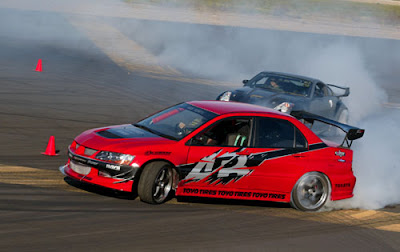
So, no surprise, a rear-wheel-drive Mitsubishi Evo is tougher to launch than an all-wheel-drive one, and this one could manage the trip to 60 mph in 6.6 seconds and complete the quarter in 14.5 seconds at 103.6 mph — a slug compared to the 4.9-second 0-60 time and 13.3 seconds at 103-mph performance of the last stock U.S.-market Evo IX Inside Line tested.For anything except drifting, the all-wheel-drive Lancer Evolution IX is a better machine. In fact, it's an all-time great
By http://www.edmunds.com
BMW E30 3 Series
Step Drift : BMW E30 3 Series
Make/ Model: BMW E30 3 Series (much of this info also applies to the larger E28 5 series pictured drifting below) 316, 318, 320, 323 and 325 available. Early cars were Carb, later cars EFI and had the "I" tag applied.Engine: Early cars were Carb, later cars EFI and had the "I" tag applied. 316(i) Engine is underpowered, 320(i) and 323(i) aren't the best either. The pick of the bunch would be the 318(i) and the 325(i), making 100hp and 170hp respectably. 318 has just enough poke to be fun, 325 has ample power and torque to play with and is great fun!Standard Differential: Clutch Type LSD offering only 20% lock, available on "Sport" Models, otherwise cars are fitted with open diffs
All models were available in 2 Door (not 5 series) 4 Door and 5 Door "Touring" versions. The Touring BMW's had slightly stiffer stock suspension. 318IS was available later on and offered a 16v engine with 140hp and LSD as standard. Various trim levels available.
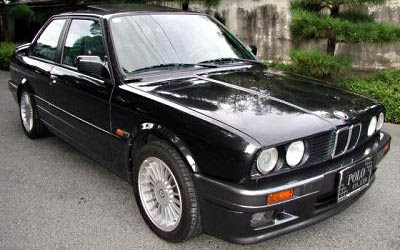
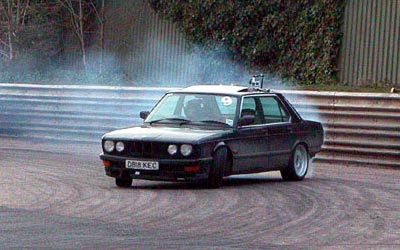
* Good to learn the basics in.
* Very cheap to buy and run.
* Chassis is excellent, very enjoyable and rewarding to drive.
* 325i requires little work to be a reasonably competative drift car.
* Abundance of spare parts and reasonably cheap to maintain and run.
* Touring is practical as well as effective.
* Lots of aftermarket parts available.
* Effective engine swaps available.
Bad:
* Steering rack has 4 turns lock-to-lock and this requires accurate and quick steering, can catch * you out easily (E36 rack swap can cure this).
* Drift oriented aftermarket parts are rare e.g Pillow Ball Uppers etc.
* Electrics are poor.
* Stock LSD is very poor, can be improved with more clutch plates or weld an Open Differential for cheaper results. Older cars getting rusty now.
By http://www.driftworks.com
Mazda RX7 FD
Step Drift : Mazda RX7 FD
Make/ Model: Mazda RX7 FDEngine:13b twin rotor, twin sequential turbo. BHP From 255 - 280 depending on model.Standard Differential:Torsen.


* Revvy.
* Responsive.
* Lots of adjustability suspension wise (toe, camber, caster etc can all have a much better adjustable range to play with than most other potential drift cars).
* Relatively simple to tune, as long as the ECU is changed to something mapable.
* 350BHP is relatively easy without changing turbos or opening the engine but would need everything else in place to support it (IC, map, fuel system etc)
Bad:
* With trim you can only transport 2 wheels in the vehicle. Slightly more when stripped, but 4 would still be a push when retaining both front seats.
* Poor handbrake.
* Very Bad MPG, especially when tuned for more power.
* Stock sequential twin turbos have a messy transition, Non sequential rebuild or single turbo is prefered.
* Lack of steering angle, but aftermarket parts available to combat this.
By http://www.driftworks.com
Toyota AE86 Corolla
Step Drift : Toyota AE86 Corolla GT Coupe
Make/ Model: Toyota AE86 Corolla GT Coupe (UK-Fixed Lights), Sprinter Trueno (Japanese-Pop-up Lights), Corolla Levin (Japanese-Fixed Lights).Engine: All AE86's came with the 4AGEU 1.6 litre Twin Cam 16v Engine. It used the 4AC 8v 3 Rib Block mated to the 16v Head. The AE92 used a 7 Rib Block and is a popular swap. Standard Differential: 1.5 Way Clutch Type LSD
The Japanese versions came in GT, GTV and GT-Apex trim levels. All have pros and cons for drifting but all are suitable. GT has lowest spec but rear drum brakes which makes the handbrake more effective. GTV is the more base/performance oriented model with Manual Steering (3.5 Turns Lock-to-lock) and manual windows and GT-Apex is the highest spec with power steering (3 Turns Lock-to-lock), electric windows and air-con as standard. They came in 2 and 3 door versions of both models. The UK GT Coupe was 3 Door only, and is basically a "GTV" in terms of trim and spec (Manual steering etc). Classic drift car as featured in Initial-D.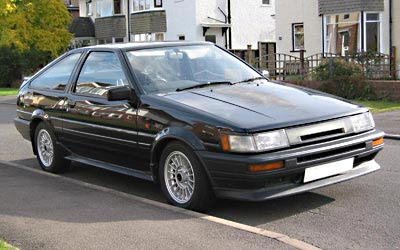
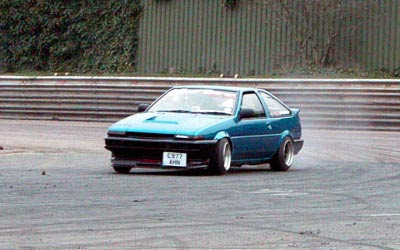
Good:
* Good to learn the basics in.
* Good to work on, easy on tires and very solid and reliable.
* The stock LSD (when working) is very good.
* Huge aftermarket support available in Japan.
* Awesome to drive and a serious amount of fun due to the light wieght and revvy engine.
* Very addictive and intoxicating to own!
Bad:
* Hard to get good in.
* Very low power levels.
* Many other cars flatter the driver, this car highlights your every flaw.
* Some cars are nearing 22 years old, and hence suspension, engines and chassis can be weak.
* Prone to rusting.
* Drive shafts can be problematic.
By http://www.driftworks.com
Nissan 200sx S14
Make/ Model:Nissan 200sx S14 - model shown is the facelifted S14a (Kouki in Japan, the earlier S14 is Zenki) called 240SX in the USA although the US model has a 2.4L normally aspirated truck engineEngine: SR20DET 2litre Turbocharged 200bhpStandard Differential: Viscous LSD on all models.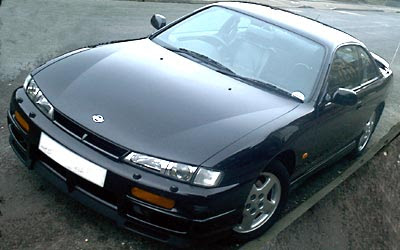

Good:
* Easily tuneable to 270bhp with simple breathing mods.
* Engine is very b when serviced well, it is capable of 400bhp with just bolt on mods and good mapping.
* A very predictable car to learn in.
* Loads of drift specific parts available off the shelf.
Bad:
* Standard suspension is very soft.
* The Viscous LSD is not great, and higher mileage units can become tired and behave like an open diff.
* Standard seats are unsupportive and leather is slidey.
By http://www.driftworks.com
Nissan 200sx S13
Step Drift : Nissan 200sx S13
You can ass-drag a FWD car and you can power understeer a 4WD car, but it's not true drifting.
Here are some examples and details on some of the most popular choices of drift car. Although there are many other suitable cars for drifting, these seem to be the most suitable in terms of value for money, standard equipment and availability of tuning parts, and spares.
Make/ Model: Nissan 200sx S13 (180sx in Japan)Engine: CA18DET 1.8litre Turbocharged 180bhpStandard Differential: Open diff or Viscous LSD depending on age and model.
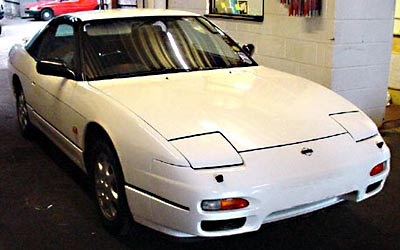

Good:
* Cheap to buy.
* A very predictable car to learn in.
* Loads of drift specific parts available off the shelf.
Bad:
* Getting old now with even the newest examples being well over the 10 year mark.
* CA18DET engine is prone to big end problems in later life, especially if over-revved.
* Standard suspension is very soft.
* The Viscous LSD is not great, and higher mileage units can become tired and behave like an open diff.
By http://www.driftworks.com
What is Drifting?
Step Drift : What is Drifting?
Drifting is a motorsport discipline that originates from Japan and is rapidly growing in popularity in Europe.
It is essentially the art of sliding a car as sideways as possible for as long as possible round a conventional race circuit, linking slides and turns into one fluid, controlled movement.
It's a unique form of motorsport in that competitions are comprised of individual runs judged on style, like in freestyle motocross or, dare I say, Ice-skating rather than the more conventional tradition of many cars on track at once, racing each other.
Although it might look like an extreme form of driving, the reality is that speeds are relatively low compared to other motorsports and when mishaps do happen, its generally just a simple spin to a halt, before carrying on to the next turn.
Drifting has been recognised in Japan for the last 30 years, but has become hugely popular there in the last 15 years and is now a fully established national sport. America is following suit and had it's first pro drift competition in mid 2003. Japanese drivers and their cars were shipped over to compete in front of a capacity crowd. The sport is currently in its infancy in Europe, but is very quickly gaining recognition and popularity both as an easily accessible amateur motorsport and a very popular spectator attraction.
In Europe at the moment, entry fees for events are relatively small and anyone with a rear wheel drive road car can take part in the entry level competitions. All that's needed is a helmet, the ability to learn and think fast and a serious passion for driving. Oh yes, and a good supply of spare tyres.
Drifting Techniques
Step Drift : Drifting Techniques
Kansei Drift- this is performed at race speeds, when entering a high speed corner a driver lifts his foot off the throttle to induce a mild over steer and then balances the drift through steering and throttle motions. Note that the car that is being used for this style of drift should be a neutral balanced car therefore the over steer will induce itself. If the car plows through any turn this technique will not work.Braking drift- this is performed by trail braking into a corner, then loss of grip is obtained and then balance through steering and throttle motions. Note that this is mainly for medium to low speed corners. Faint Drift- this is performed by rocking the car towards the outside of a turn and then using the rebound of grip to throw the car into the normal cornering direction. Note that this is heavy rally racing technique used to change vehicle attitudes during cornering, mainly tight mountain corners.Clutch Kick- this is performed by depressing the clutch pedal on approach or during a mild drift, then pop the clutch to give a sudden jolt through the driveline to upset rear traction.Shift Lock- this is performed by letting the revs drop on downshift into a corner and then releasing the clutch to put stress on the driveline to slow the rear tires inducing over steer. This is like pulling the E-brake through a turn - note that this should be performed in the wet to minimize damage to the driveline, etc.E-Brake Drift- this technique is very basic, pull the E-Brake or (side brake) to induce rear traction loss and balance drift through steering and throttle play. Note that this can also be used to correct errors or fine tune drift angles.Dirt Drop Drift- this is performed by dropping the rear tires off the road into the dirt to maintain or gain drift angle without losing power or speed and to set up for the next turn. Note that this technique is very useful for low horsepower cars.Jump Drift- in this technique the rear tire on the inside of a turn or apex is bounced over a curb to lose traction resulting in oversteer. Long Slide Drift- this is done by pulling the E-brake through a strait to start a high angel drift and to hold this to set up for the turn ahead. Note that this can only be done at high speed.Swaying Drift- this is a slow side-to-side faint like drift where the rear end sways back and forth down a strait. FF Drift- or front wheel drive drift. The E-brake as well as steering and braking techniques must be used to balance the car through a corner. Note that the E-brake is the main technique used to balance the drift.Power Over- this performed when entering a corner and using full throttle to produce heavy oversteer (tail slide) through the turn. Note that you need horsepower to make this happen.
By AE86 Drift
AE86 Story
OK this Sprinter mightn't kick like a turbo car, have stand-out paint or a mega sound system, but what it does have is good. Bloody good. Matter of fact, it's a mechanical marvel and an absolute credit to its owner builder, Steve Vasic.
Now that you'd know it at first, second or even third glance. No. The Sprinter is exceptionally understated regardless of its imported Japanese Corolla GT front, neat black TSW rims and raspy exhaust note.
There's nothing initially inspiring about sitting in the imported Sprinter passenger seat either - except perhaps for the slightly bumpy ride. But this changes once Steve breathes on the loud pedal. Watching the tacho reveals steady progress up to around 4000 rpm before the momentum increases and the engine takes on a very different complexion in both feel and sound.
Steve grabs for the shifter as the tacho rises above 7500 rpm, pulls second and we continue our leap forward at a pace not expected of a normally boring Sprinter. And even though it's a quick car, straight line grunt was never meant to be its forte. No, built it to club race but now believes the finished product is too good to subject to the track.
Mind you, Steve recently ran the car over Calder Park's quarter mile. On the day he pushed the Sprinter to just one pass, an abysmal launch giving a 15.22 at 89 mph.So what is it that makes the car so quick, so nimble and so mechanically marvellous? Man, you're not going to believe what you're about to read.
Steve's no spring chicken, in fact he's knocking on the door of the big four zero but hey, here's a guy who's been-there-and-done-that with all things automotive. He's pretty much stuck with Toyota and Subaru product, having performed some really interesting conversions along the way. Trick stuff like dropping a 1988 model Subaru Touring wagon over a complete - that's the works - RS Liberty 4WD turbo drive line! Yeah, we know that it's supposed to be an impossible swap - but Steve has done it...

Over four Years ago (and prior to it becoming popular) he swapped a Holden EFI V8 into a Landcruiser, even ensuring the 'check engine' light was operational. Then there's been at least three '74 Corollas running a 2TG hybrid or 3TG turbo engines and, well, the list goes on an on.
There's been a couple of Sprinter too, with this one making its entrance three years ago, soon after Steve received a telephone call from EKW's Andrew Perrera about a front damaged 1983 Sprinter. "I'd been thinking about another Sprinter for a while, so I went and had a look to find it was a one owner and meticulously cared for", Steve said.
A rebuild was in order simply because the car needed a new front anyway, so Steve looked at what was required to transform it into a competitive club level road and race car. A 1G-G twin turbo 2.0-litre six was first cab off the rank, however it proved to be quite heavy and its size meant that the car would be in the over two litre class. "I wanted to stick with a Toyota engine, and about the only high-tech two litre in the range was the second generation MR2 3S-GE. I knew that by virtue of it being a transverse engine it'd make for a difficult conversion, but I like a challenge".
And what a challenge it was! Mods required to make 118kW (158bhp) engine work in harmony with the Sprinter were many - too many to mention here. For a start, the normally slant-mounted engine had to sit upright. This meant that Steve had to drill three holes (one front and two rear) in the cylinder head for oil delivery via high pressure fittings. External lines lead to just above the sump line in the block casting, allowing the oil to run back into the sump.
The inlet manifold also had to be radically altered due to the original transverse configuration. It starts with 35mm of the original manifold (match ported) to which 15mm sections of an 18RG twin Solex manifold were welded, with the internals incorporating trumpet style inners. Flange mounted to the already radical manifolds is an owner-made allow plenum designed to accept the factory throttle body. Also, in the event that Steve decides to revert to a complete MoTeC injection package (neatly stored in the home shed), he has simply to remove the fabricated manifold and bolt on 45mm MoTeCthrottle bodies.
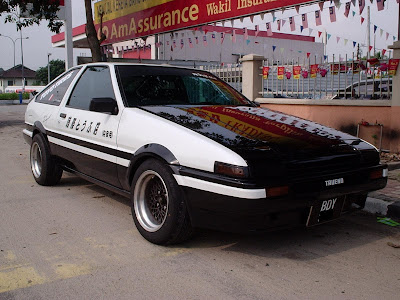
Next the water inlet pipe had to be cut and shut and turned in the opposite direction to run along the underside of the inlet manifold to the front of the engine. A similar situation was faced with the dizzy, however the fix wasn't so simple. Steve relocated the rotor button and cap to the front of the engine and sealed the rear dizzy. An adaptor plate turns the exhaust camshaft into a new dizzy drive!
Necessary were custom made 4-2-1 extractors meeting in a 2.25-inch pipe. This runs to a high-flow cat, into a small resonator and then finally through a stainless Genie muffler. The extractors aid power output, as does a fully sealed cold air intake mounted fore of a Subaru RX turbo air box and drawing air from behind the grille.
Engine accommodation was also a significant exercise with Steve placing and AE82 Corolla twin cam air conditioning fan in front of the stock radiator on a fabricated bracket, employing Corona 2S engine mounts sitting on a modified cross-member and placing a 4A-GE Sprinter washer bottle on the left hand inner guard - not on the stock right hand side. The radiator overflow has also been relocated to a possy between the grille and radiator.
Choosing the trans type was made easier thanks to Steve discovering a reasonably priced 4.3 LSD Sprinter rear end, which meant that a tall first and second geared W58 Supra five-speed was just perfect. It sits in front of a fabricated light-weight flywheel and slightly second hand 1G-G clutch, is backed with a modified 2-piece tailshaft and sits on a spaced imported Corollo auto crossmember.
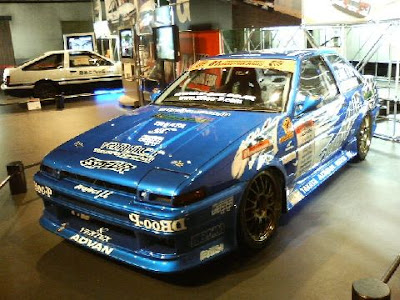
Suspension bump and rebound have been attended to through the addition of adjustable Koni shocks on the rear with 1.5-inch lowered King springs. The front sits on custom shortened adjustable spring height Lesle coil-overs and there's a bunch of Nolathane bushes. Braking is more than adequate thanks to current model Cressida rotors (owner cross-drilled and grooved and new RX-7 Series 4 alloy calipers. Rolling stock consists of TSW Racing rims and Pirelli rubber.
Turning to the interior about the only changes are a Momo steeting wheel, electric mirrors and retrimmed imported Sprinter bucket seats. Outside it's a similar story except of course for the complete Corolla GT front sheet metal, pop-up headlights and grille. Finishing off the look is a rear spoiler, Calibra roof-mount aerial and two-tone Glasurit paint job.
Unseen modifications are also in force, most small yet significant. One is the Corolla GT fuel tank and in-tank pump, oversize line runs from front to back, and a spare tire that has been displaced in favour of 15 inch (needed to accomodate the larger brakes) Nissan 300ZX 'space saver'.
An incredible amount of work you'd have to say, all achieved in an amazingly short five months! Yep, Steve performed almost everything himself including parts sourcing and most fabrication. What's more the car is fully read legal. It's great lesson in high quality engineering.
AE86 Drift
How to Drift 2
How to Drift
With the popularity of the movie, Fast and the Furious – Tokyo Drift, a lot of car enthusiasts are amazed with the drifting techniques showed in the film. Drifting is a type of technique used popularly in motor sports.
To illustrate a drift, the rear slip angles are basically higher than the front ones. The front wheels points to an opposite direction when doing a turn. For example, if a car is turning right, the wheel should point to the left. Drifting is a technique that is manipulated by the driver himself.
If you are ready for some adrenaline rush, here are a few tips on how to drift:
1. Make a checklistThe first things that you need to do when going for a drift is an extra powerful car. It should have the following minimum requirements:• Rear wheel drive• 400hp minimum horsepower
• Strong and good working tires
• Powerful suspension
2. Find a suitable carIf you wanted to go for a rear wheel drive drift, then look for a car with manual transmission and of course, a rear wheel drive. Remember that no two cars are alike and they each have different responses so it is best that you use a car that you are already familiar with.
3. Spotting a good locationLook for an open area. One good place is an empty and spacious parking lot, where there are no pedestrians or other cars that would get in your way. If you are a beginner, choose a location with gravel because gravel proves to be a good platform for your tires.
4. AccelerationThe key to drifting is good acceleration. To get you started, accelerate and shift to your 2nd gear. This would allow for several speed varieties. It could also harness your car engine’s torque but would not distress its mechanism.
5. RevOnce you get accelerated and heated up, push the clutch and rev.
6. Preparing for the driftWhile the car’s engine is revving, give your steering wheel a good yank. Move it slightly to the right and left. This would make your rear end loosen up its grip and traction.
7. Get startedThere are three things that you need to do to lose the rear wheel traction. Simultaneously do the following. First, steer your wheel close to half of its race. Second release your clutch. Lastly, pull the handbrake. This would cause your car to slide away.
8. Drift awayAfter doing step no.7, steer your car right away in the direction of the slide. And that’s it, you are drifting!
By http://www.driftworks.com
How to Drift a Car
stepdrift : How to Drift a Car
Drifting with Rear Wheel Drive Manual
- Find a car with both rear-wheel-drive and a manual transmission.
- Head to an open area (i.e. an empty parking lot) safely free of pedestrians and motorists.
- Accelerate and shift to second gear, which allows the widest variance of speed and is best for harnessing the engine's torque without overly stressing the mechanicals.
- Push in the clutch to let the engine rev.
- With the engine revving, flick the steering wheel to the outside of the turn and steer strongly inside toward the turn.
- Simultaneously release the clutch. If you are uncomfortable with this method of sliding, try pulling the hand brake to further reduce traction(never pull brake while accelerating). While that won't kill your car initially, it is a bad habit to get into. Don't start now.)
- Immediately steer the car in the direction of the slide. You're drifting!
Drifting with Rear Wheel Drive Auto
- Find a large, open area.
- Accelerate to a speed of 20-30(depending on lot size and room)
- Turn the wheel hard and floor it. You should feel the rear end slide around if this is done correctly. Repeat until comfortable with sliding.
- Set up a cone in the middle of the lot. Drive up on the cone and turn around the cone. when you begin your turn accelerate hard to get the rear end loose.
- Counter steer to control where your car will go after turn.(opposite lock)
- Increase speed until comfortable
- Note that if your vehicle of choice doesn't have enough power read the FWD directions but remember to release hand brake before accelerating.
Drifting with Front Wheel Drive
- Go to a large, open area.
- Accelerate then pull the handbrake or use the parking brake, riding it out the first time or two to get over your initial fear.
- Set up a cone in the middle of the lot.
- Drive up to it at speed (between 20 and 30 is desired).
- Hit the brake and turn toward the cone. Immediately after you feel the back end come around, turn to the opposite direction. This is known as opposite lock.
- Repeat the opposite lock at that speed until you can control your car well. Practice this for at least several weeks regularly until it becomes second nature. (Don't do this on roadways. It is dangerous to others and can get you fined.)
- Slowly increase speed until you are proficient in a speed you are comfortable with. Get to know that speed--you should never drift above that speed unless you are practicing.
- Upgrade. At the same initial speed, flick the steering wheel opposite of the turn and swing it all the way into toward the CONE (not turn, you aren't ready at this stage). As before, when you feel the rear end come around, go to opposite lock. It takes time and practice to successfully use the Scandinavian flick, especially on under powered cars.
Tips
- No two cars react identically; try to "feel" yours to familiarize yourself with its reactions.
- All wheel drive vehicles can be drifted, but it requires a specific, rather more difficult technique. Keep in mind that there are no rules that can be applied to AWDs because every car is different and more importantly, every AWD system is different. Read about your car, read real articles on it and go talk to people. If they tell you that you must drive rear wheel drive, find someone else.
- In a rear wheel drive vehicle, you don't need to pull the brake as you improve, but it is often necessary when first learning.
- When looking for an area to learn and practice, gravel is preferable because it is easier on your tires.
- This is only a starting point. To do more, you need driving school to teach more than just basic maneuvers and you need driving theory.
Things You'll Need
A car with
- wheels
- some horsepower(more the easier)
- tires(slick tires on the rear is good for sliding, but it is bad for street driving)
- suspension(if you fear body role, tight set up. Try reading up on suspension because you can collapse your rear suspension if you aren't careful or if you are unlucky)
- A track race
- a good engine
Warnings - Never drift on the road. It is illegal. It might seem fun, but it's really not worth the risk.
- Don't go faster than you can handle. Recovering from a spin takes skill and experience.
- Because severe or uneven wear is a driving hazard, be sure enough tread remains on the tires when finished drifting.
- Be extra careful when drifting in an SUV or pickup. They're more likely to flip.
http://www.wikihow.com
